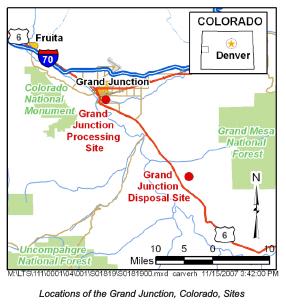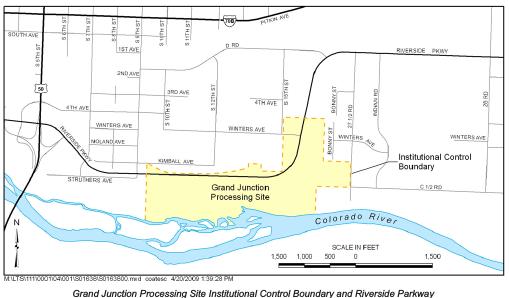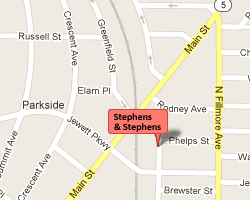Climax Uranium Mill In Grand Junction
Home / Areas of Practice / Energy Employees Occupational Illness Compensation Program Act (EEOICPA) / EEOICP: Facility List / Climax Uranium Mill In Grand Junction
State: Colorado
Location: Grand Junction
Time Period: DOE (Remediation) December 1988 – August 1994
Facility Type: Department of Energy
Facility Description
During its 19 years of operation, the mill produced 2.2 million tons of radioactive tailings. These years of operation are covered under the auspices of the Radiation Exposure Compensation Act and are not separately covered under EEOICPA. However, DOE environmental remediation contractors performed environmental remediation under the Uranium Mill Tailings Radiation Control Act (Public Law 95-604) at this former uranium ore processing mill from at this former uranium mill from December 1988 through August 1994. DOE and DOE contractor employees who performed this remediation are covered under EEOICPA.
Listing
Climax Uranium Mill in Grand Junction is listed as a Department of Energy (DOE) site under the EEOICPA.
Compensation
As of 03/15/2015, the total compensation paid under Parts B and E of the EEOICPA, including medical compensation, for workers suffering from the effects of having worked at the Climax Uranium Mill in Grand Junction is $853,542.
Climax Uranium Mill in Grand Junction Workers
If you or your parent worked at this or any other DOE or AWE facility and became ill, you may be entitled to compensation of up to $400K plus medical benefits from the US Department of Labor. Call EEOICPA Counsel Hugh Stephens at 1-855-EEOICPA (336-4272) or fill out the form to the right, whether or not you have already filed a claim and even if your claim has been accepted or denied.
We can help with all OWCP (Federal Workers Compensation) claims, impairments, wage loss and health care. 2495 Main Street, Suite 442 Buffalo, NY 14214.
Site Description and History
The former Grand Junction processing site, historically known as the Climax uranium mill, occupies 114 acres at an elevation of about 4,600 feet above sea level in the broad, arid Grand Valley in west central Colorado. The former mill site is located on land owned by the City of Grand Junction in an industrial area along the north bank of the west-flowing Colorado River. The facility began in 1899 as a sugar beet mill. In 1950, the Climax Uranium Company reconfigured the original site and operated the facility as a uranium and vanadium mill until 1970. During 19 years of operation, the mill produced 2.2 million tons of radioactive tailings, a predominantly sandy material.
From 1950 to 1966, tailings were available to private citizens and contractors, who used them as fill and as a component of concrete and mortar. Radioactive tailings were hauled to more than 4,000 private and commercial properties in the Grand Junction area. In 1966, concerns about potential adverse health effects from mill tailings prompted the Colorado Department of Health to sample the tailings for radon-222, and preliminary results indicated elevated levels. Although that finding caused Climax to discontinue release of tailings from the site, an estimated 300,000 tons of tailings containing radioactive uranium daughter products had been removed by that time.
During 1970 and 1971, the Climax Uranium Company demolished 8 of the 12 main mill buildings at the processing site. Equipment that could be decontaminated was sold; equipment that could not be decontaminated was buried in the tailings pile along with building rubble. Demolition of the remaining buildings, except the old sugar beet warehouse, was completed in 1989. The sugar beet warehouse has since been cleaned, sold to the private sector, and is now located outside the fence separating the city-owned property from adjacent private properties along the northern boundary of the site.
Surface remediation of the processing site and contaminated private and commercial properties, known as vicinity properties, began in the mid-1980s. The U.S. Department of Energy (DOE) conducted radiological surveys at all vicinity properties and remediated those where mill-site-related radium-226 or radon levels exceeded established maximum concentration limits. Tailings and other contaminated materials removed from vicinity properties were stored temporarily at the processing site.
Construction of the Grand Junction disposal site, at that time called the Cheney disposal cell, began in 1990 about 18 miles southeast of Grand Junction. All contaminated materials from the former processing site and all vicinity property materials temporarily stored at the site had been transported to the disposal cell by the end of 1994. About 4.4 million cubic yards of contaminated materials were placed in the cell. DOE completed cleanup of vicinity properties in 1998 under the Uranium Mill Tailings Remedial Action Project.
The three main hydrogeologic units beneath the former processing site are the unconfined alluvial aquifer (the uppermost aquifer), the underlying aquitard composed primarily of shale units in the Cretaceous Dakota Sandstone Formation, and the confined aquifer in sandstones of the Dakota Sandstone.
The alluvial aquifer is composed of unconsolidated clays, silts, sands, gravels, and cobbles. Groundwater is unconfined in the alluvial aquifer; depth to the water table ranges from zero near the river to approximately 20 feet at the northern boundary of the site. The saturated thickness of the aquifer ranges from 5 to 20 feet. Groundwater generally flows west-southwest toward the Colorado River.
Groundwater in the alluvial aquifer beneath the site is contaminated as a result of past milling activities. Contamination extends approximately 3,300 feet downgradient from the site. Site-related contaminants in groundwater discharging to the Colorado River are quickly diluted and have no measurable effect on river water quality.


Share this:
EEOICPA CLAIMS
If you or your parent worked any of the DOE or AWE facilities listed on this website and became ill, you may be entitled to compensation of up to $400K plus medical benefits from the US Department of Labor.
Call EEOICPA Counsel Hugh Stephens at 1-800-548-4494, email hstephens@stephensstephens.com, or fill out the form below whether or not you have already filed a claim and even if your claim has been accepted or denied.
Contact Us
"*" indicates required fields
*note: Submission of this form does not establish an attorney-client privilege.
Contact Us
Address:
2495 Main Street, Suite 442
Buffalo, New York 14214
Phone:
(716) 852-7590
Fax:
(716) 852-7599
After Hours:
(716) 208-3525
Email Us:
R. William Stephens, Esq.
R. Hugh Stephens, Esq.
Lisa P. Neff, Esq.

